

|
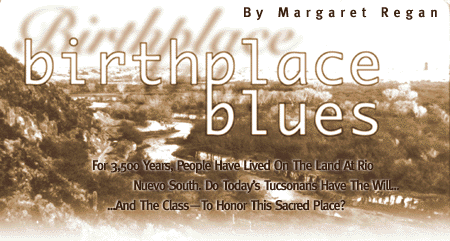
IN THESE DAYS of the El Niño rains, the land at
the eastern foot of A Mountain is even more desolate than usual.
A damp wind blows across the barren flats, ruffling the colonies
of weeds that thrive atop the buried trash dumps. The breeze sails
on over the Santa Cruz, a river so dead it's wet only when it
rains, then hits the tacky motels on the other side before disappearing
into the ungainly elevation of the freeway. And if the river is
dead, so is the land. Beyond wild grasses and a few scraggly trees,
there's hardly a living thing to be seen on this beaten-down patch
of dirt. Everywhere, though, there are shards of glass, survivors
of countless beer parties, and the noise of the glass crunching
underfoot punctuates the monotonous roar of the highway.
Welcome to the birthplace of Tucson.
"There's a spirit in that piece of earth," says Daniel
Preston, vice chairman of the San Xavier District of the Tohono
O'odham Nation. "The spirit of my ancestors that have prayed
and used the land in a respectful religious way."
 Nowadays one would be hard pressed to find a respectful spirit
toward the big tract of riverfront land just west of downtown,
south of Congress Street. Tucked between the sacred mountain and
the once flowing river, this exhausted patch of earth is an urban
eyesore, home only to a bus barn and a bunch of landfills that
were closed in the 1960s. There's a small neighborhood, though,
Barrio Sin Nombre, that still clings to its western edge, and
its inhabitants are the latest in a long line of people who have
lived on this spot for at least 3,500 years.
Nowadays one would be hard pressed to find a respectful spirit
toward the big tract of riverfront land just west of downtown,
south of Congress Street. Tucked between the sacred mountain and
the once flowing river, this exhausted patch of earth is an urban
eyesore, home only to a bus barn and a bunch of landfills that
were closed in the 1960s. There's a small neighborhood, though,
Barrio Sin Nombre, that still clings to its western edge, and
its inhabitants are the latest in a long line of people who have
lived on this spot for at least 3,500 years.
For more than three millennia, Chuk-shon, Place of the Black Spring,
sustained human life. It was a desert oasis, full of cottonwood
trees, marshes and ponds, a place where wildlife was abundant
and where nomadic desert dwellers had the luxury of not worrying
about water. Those who lived here over the centuries--archaic
people, Hohokam, Pima, Spanish, Mexicans, Apaches and Anglos--drank
from the spring and the river, and they used river water to irrigate
their fields in the fertile flood plain. As late as the turn of
this century, 15 different species of ducks were recorded among
its reeds. The site is remarkable and possibly unique.
"For 3,000 years, there's been continuous human use and occupation
at the base of Sentinel Peak," says Linda Mayro, cultural
resources manager for Pima County. Some historians believe it
may be the longest continually occupied site in North America.
Yet less than a century and a half after the U.S. became steward
to this land, the river's run dry and its lush shores have been
denuded and trashed. Long gone are the cottonwoods and the ducks.
An 18th-century adobe Convento abandoned by Spanish priests crumbled
to dust, making way for trash dumps. A 20th-century brickyard
came and went. (Preston says the remains of his ancestors, quarried
from the site's mud, went into the bricks). A boxing gym and a
supermarket followed the brickyard into oblivion. A homeless camp
at the southern end, on the A Mountain Landfill, was emptied out
by force by city workers. Apart from a recreational river park
snaking along the dry channel, the forlorn survivor on the vast
tract of 90 acres is the Citizen's Auto Stage bus barn.
In the late '80s, the whole place--archaeology, history, ancestors
and all--was scheduled to be buried forever under a new four-lane
highway. Clever protesters, including some guerrilla activists
who concocted a makeshift shrine by night and orchestrated a highly
publicized religious ceremony by day, sent the road plan down
to defeat. Nothing much has happened there since. Meantime, day
in and day out, the buses bounce past the ancient graves.
"My parents are back in this earth," Preston maintains.
"People putting trash on it put trash on my parents."
LATELY, TUCSON HAS begun to think again about its trashed
birthplace. The long hoped-for Mission San Agustín del
Tucson Cultural Park, a history and archaeology interpretive park
planned since 1991, is at last gaining momentum, with the city
and Pima County working to acquire the final patches of privately
held land at the tract's center, along Mission Lane (see accompanying
story). A group from the nearby Kroeger Lane neighborhood has
enlisted a team of architecture students and professors to help
design a proposed park on the A Mountain Landfill, which the city
owns.
And Preston delivered his mournful remarks by invitation at a
meeting last month of the Santa Cruz River Project Citizens Advisory
Commission. This group of eight local bigwigs and neighborhood
leaders, appointed last October by City Manager Luis Gutierrez,
will make a recommendation for what to put on Rio Nuevo South,
the 44 acres of city-owned land at the northern end of the tract.
This piece of long-vacant land may well prove the trickiest to
develop. Burdened by landfills and archaeological treasures alike,
it's nevertheless enjoyed a flurry of proposals in recent years.
A baseball park, a campus for the "new university"--the
school that became Arizona International Campus of the University
of Arizona--and even a Colonial Tucson theme park have all had
their champions during the 1990s. Right now city leaders say they're
determined to come to a decision, and soon. The commissioners
have been holding hearings to entertain any and all proposals
for Rio Nuevo South. (Their larger mission is to come up with
ways to better the dispiriting condition of the dry river.) Eventually,
maybe even this summer, they'll tell the city council what they
think is the best use of the land.
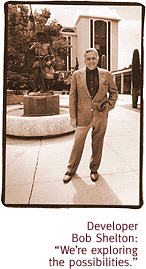 Gutierrez, a Tucson native, explains that the mission of the commission
is fourfold.
Gutierrez, a Tucson native, explains that the mission of the commission
is fourfold.
"The mayor and council have directed that the city look to
use the property in a sensitive and careful way," Gutierrez
says. Any new project for Rio Nuevo South has to "enhance
the revitalization of downtown, to provide direct benefit to the
adjacent neighborhood in the form of job opportunities, and to
reflect the history and culture of the community."
IT'S A TALL order, certainly, but developers sniffing around
for opportunities have not failed to materialize. After all, as
Carol Carpenter, a downtown specialist in the city's Office of
Economic Development, points out, it's rare to find such a huge
tract of land ripe for development so close to the heart of a
growing city.
"There's no doubt," she says, "that the development
community wants this 44 acres in the worst way." Plus, the
value of whatever goes in there can only be enhanced by the cultural
park that will go in at its southern flank.
Dreams are not in short supply. Among the contenders:
- A local consortium wants to build a complex of three or
four museums, abetted by some shops, restaurants and parking.
It would include newer, bigger versions of the Arizona Historical
Society museum and Flandrau Planetarium/Science Museum, both of
which are cramped in their present locations by the UA. There
would be room for another small museum, to be determined, and
possibly an outdoor performance center that could be used by the
Tucson Symphony Orchestra and other arts groups. Its flagship
and big tourist draw, promoters hope, would be the Museum of the
American West, a brand-new enterprise that hopes to get its goodies
on long-term loan from the Smithsonian Institution. (More on that
later.)
- Then there's the California developer called Dunhill Ltd.
whose officials imagine a dense, upscale retail/entertainment
complex with concealed parking structures. Complete with a hotel,
three department stores, a multiplex cinema, even housing, the
Dunhill project is a high-end attraction whose labyrinthine bridges
and archways look ominously reminiscent of the failed La Placita
downtown. David Hoyt Johnson, a downtown resident and arts administrator,
compares the design's treatment of public space favorably with
Horton Plaza's in San Diego; a rival developer dismissed its upper-crust
ethnic chic as "Barrio Nordstrom."
- Some cheerful oceanographers pushing for a Sonoran Sea
Aquarium seemed to win over the skeptical commissioners at the
March meeting with a highly entertaining slide show full of loggerhead
turtles and crabs with coral on their backs. Shannan Marty told
the commissioners that the nonprofit aquarium would concentrate
solely on the 10,000 species inhabiting the Sea of Cortez. "Having
an aquarium would make Tucson the gateway to Mexico," she
said. Occupying only two acres, the aquarium could join forces
with one of the other developers.
- Jack Camper, president of the Tucson Metropolitan Chamber
of Commerce and a member of the commission, promises to regale
his fellow commissioners at a future meeting with plans for a
River Walk, inspired by San Antonio's successful attraction of
the same name. Tucson's version would consist of a channel dug
in the bed of an old rail line east of the river; the channel
would cross the real riverbed and extend over into Rio Nuevo South.
- More hopefuls will take to the podium at the meeting next
week, Wednesday, April 15. Bob Shelton, the man who developed
Old Tucson as a tourist attraction in 1959, has downsized his
old proposal for a Colonial Tucson theme park. Reinvented as San
Agustín Square, it would be a more modest 15,000 to 20,000
square feet of artsy shops and restaurants, highlighted by an
outdoor amphitheatre suitable for tourist-attracting sound and
light dramas about Tucson's history. Shelton says he's been talking
informally with the museum group for about a year about joining
forces. "It's led to some quiet dialogue. We're continuing
to talk. There's no commitment. We're exploring the possibilities."
- Pat Darcy and Pete Villaescusa, a pair of local brokers,
will present a plan by Daystar of Woodland Hills, California.
Darcy, a former Cincinnati Reds pitcher who once pushed for a
baseball stadium on the site, said Daystar specializes in inner-city
development. Right now the company is constructing an entertainment
and retail complex in downtown Bakersfield, California.
Clearly these projects are costly, and various ideas have been
tossed around about public funding, at least for the nonprofit
museum complex. At the moment, though, says Albert Elias, the
city staffer who's moderating the meetings, no one's nailing anybody
down to financial specifics. A few developers have criticized
the city for not issuing an official request for proposals, but
Elias says RFP's will come after the city council votes on the
direction they want to go. One thing, though, should be paramount
to anybody with designs on the site:
"Whatever happens in Rio Nuevo South has potentially a great
impact on the Convento site and the park," Elias says. "We
have some unanimity here. We don't want Disneyland. We want only
what's culturally appropriate and respectful."
THE ELEGANT NOTION to bring the Arizona Historical Society
museum to the place where Tucson was born has been around at least
since 1991, when it was suggested in a city concept plan for the
cultural park. Right now considerations more practical than philosophical
are pushing it.
"We're out of space," says Jerry Kyle, director for
the Southern Arizona Division of the AHS. "I can't take care
of the kids who sign up for our summer programs. Our collections
are bursting at the seams."
The AHS now is in a fine building by the university; it houses
public exhibitions, a library, storage and offices. What Kyle
would like to see is a new building in the historic birthplace
of Tucson where he could offer lots of exhibitions; the research
and storage would stay back at headquarters on Second Street.
The prehistoric ruins near Rio Nuevo South "would be perfect
for us. We would build sensitively to the features found on the
land, and deal with them interpretively. The (restored) Convento
would be a perfect neighbor for us."
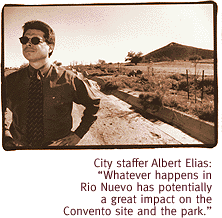 Likewise, Flandrau is cramped within the university campus, says
Joe Ruggiero, director of exhibits. The planetarium and science
museum serves 20,000 schoolkids a year, he said, adding, "One
of the problems with Flandrau is it's buried within the university.
We have parking problems."
Likewise, Flandrau is cramped within the university campus, says
Joe Ruggiero, director of exhibits. The planetarium and science
museum serves 20,000 schoolkids a year, he said, adding, "One
of the problems with Flandrau is it's buried within the university.
We have parking problems."
To promote the idea of the museum campus, Kyle has joined forces
with Flandrau officials and with Paul Lindsey, a Tucson real estate
broker most recently in the news for his part in a deal to put
apartment buildings east of historic Armory Park. That project
stalled after neighbors protested, but Lindsey has a new one.
He's been working to get a museum in the Smithsonian affiliate
program for Rio Nuevo South. Lindsey half jokes that the site
is riddled with enough woes to scare off the most intrepid of
developers: "It's got environmental problems (from the landfills),
flood plain issues, archaeological resources: It's got everything
but spotted owls." Nevertheless, he's giving it a go, aiming
for a museum that would showcase western life from the early Native
Americans to the cowboy.
Though both Kyle and Lindsey maintain that their plans are preliminary,
they've already done quite a bit of legwork, trucking around rough
architectural drawings to assorted members of the city council,
to the Santa Cruz River Commission and to the Menlo Park Neighborhood
Association. Lindsey paid a visit to Smithsonian officials in
Washington, D.C., last summer. So far their diligence seems to
have borne fruit. While everybody insists the Rio Nuevo South
selection process is still wide open, the city has been taking
action that could help pave the way for the museum complex.
City lobbyists have been up in Phoenix, working to revamp legislation
that would allow for a "cultural and museum improvement district."
It would permit an additional property tax, which supporters say
would cost the average taxpayer an additional $3 a year, and raise
about $15 million a year for museums and cultural institutions
all around town. Some of that money, says Council member Steve
Leal, Ward 5, would help pay for the new historical park, "We
need money for capital to rebuild it, to hire staff to oversee
it." A new museum complex could also dip into those funds.
On March 2, the council passed a "memorial" backing
the idea of the Smithsonian affiliate at an unspecified location
downtown, and sent the beribboned document off to the Smithsonian's
governing board. In a background memo he wrote to the council,
City Manager Gutierrez enthused, "A Smithsonian National
Museum of the American West in downtown Tucson would provide the
kind of regional and national draw this city has been seeking
for some time. Smithsonian facilities typically draw an estimated
one million people each year to an area, and are an incredible
economic engine for other commercial enterprises."
But the Smithsonian doesn't exactly see the project in the same
light that Tucson boosters do. Spokesman David Umansky cautions
that "there will not be a museum that can call itself the
Smithsonian Southwest, there will be no building whose first name
is Smithsonian, no new museum named Smithsonian Something. It's
a lot less than people think. The media always talk about the
Smithsonian coming. Museums have sometimes exaggerated in their
fundraising. The wish is the father to the thought."
And Tucson is far from being the first or the only city to tap
into the Smithsonian's new affiliate program. In point of fact,
program coordinator Tracy Goldsmith says her office has received
about 100 inquiries from existing and potential museums. The Smithsonian's
secretary, I. Michael Heyman, announced in the fall of 1996 that
his institution would allow long-term loans to carefully selected
museums. The Smithsonian has more than 140 million objects, in
an infinity of subject areas, and on any given day displays less
than 1 percent of its holdings. The idea is to take some of the
artifacts out of storage and share the wealth in museums around
the country through renewable 10-year loans. The recipient museums
foot all the bills.
So far, the Smithsonian has signed "memos of understanding"
with eight different museums, meaning that they're working toward
a "collaboration in the long term," says Goldsmith.
The Tucson group has yet to sign anything. None of the eight museums
who have signed have advanced to the final stage of a loan deal,
though the National Museum of Industrial History, to be housed
in the old Bethlehem Steel plant in Pennsylvania, apparently is
closest. But Arizona may already be moving toward a surfeit of
Smithsonians. Of the eight museums to have already signed the
memos, two are elsewhere in Arizona.
The Bisbee Mining and Historical Museum is getting a new Bisbee
Mineral Hall, expected to feature some 200 minerals from the Smithsonian
collections. It will be "an environmental exhibit, not cases
of minerals," director Carrie Gustavson says with delight.
A replica of a mining "stope," or cave, the exhibit
will be adorned with life-size historic photographs and embedded
with minerals.
Possibly of more tourist-stealing potential to Tucson is the Scottsdale
Museum of Progress, an ambitious undertaking planned for the Galleria,
a 600,000-square-foot failed mall with atrium. It already hosted
a popular traveling Smithsonian show last fall. Though director
Hal Becker is still in negotiations to buy the building, he's
collaborating with the Smithsonian to figure out just which artifacts
will illustrate the museum's large theme of progress.
"We're going to track change, through naturally occurring
events, hurricanes, volcanoes, asteroids," says Becker, "and
change through human interactions, agriculture, the Industrial
Revolution and the Information Revolution."
ON A SMALLER scale, back in downtown Tucson, the change
that's coming to Rio Nuevo South has some folks worried. If city
officials hope the new development, whatever it turns out to be,
will be the "economic engine" that revs up downtown,
the merchants on East Congress fear it will be more like a sputter.
Isolated behind the elevated highway, the new historic park may
well teem with tourists, but those same tourists may well do all
their shopping and lunching in the restaurants at hand in Rio
Nuevo South. Even with the trolleys that have been proposed to
carry everybody from the attractions on the west bank to those
on Fourth Avenue and downtown, many believe that tourists will
jump back into their cars and drive off.
"It's not gonna take business away from us," says James
Graham, owner of The Grill restaurant. "But it's another
missed opportunity for downtown....Trolleys? Please give me a
break...the trolley is not going to work. People drive their cars.
This is the West."
Hazel Rugg, proprietor of Yikes/Picante on Congress, discouraged
by the current downswing in business downtown, agrees. "By
the time all this stuff gets done, I don't know whether I'll be
here. Retail is bad all over...I like the idea of a museum complex.
But it's too far away to have a positive influence on me."
Even Carpenter, the relentlessly optimistic downtown specialist
in the Office of Economic Development, says, "I share their
concerns. If we are not careful, there will be an imbalance."
Elected officials voice the same fear. "I don't want to detract
from the merchants," says Ward 2 Council Member Janet Marcus.
Jerry Anderson, Ward 3, and Leal favor minimizing stores and restaurants
at Rio Nuevo South, to encourage visitors to hop on the shuttle
and go downtown to lunch and shop. José Ibarra, whose Ward
1 includes Rio Nuevo South, says the scary Congress Street underpass
at I-10 needs to be redesigned to be more pedestrian-friendly.
Designed in a coherently historic fashion, it could lure tourists
over to the new Visitor's Center to be built on the east side
of the highway and thence to downtown.
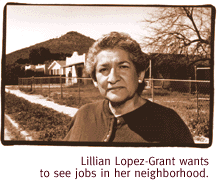 Anne Lawrence, president of the Armory Park Neighborhood Association,
isn't buying it. She sees a giant new complex, whether commercial
or educational, as just one more peripheral development that will
help sap the life out of a downtown increasingly isolated by bigger
and bigger highways.
Anne Lawrence, president of the Armory Park Neighborhood Association,
isn't buying it. She sees a giant new complex, whether commercial
or educational, as just one more peripheral development that will
help sap the life out of a downtown increasingly isolated by bigger
and bigger highways.
"What are you going to do with the core?" she asks.
"Why does everything require a new building on the periphery?
And why does it require my tax support?"
The city is not yet publicly talking finances, but there have
been rumblings about a public subsidy that has the potential to
undercut private merchants. Supposing, restaurateur Graham says,
the museums end up getting the land for a dollar a year, as they're
hoping. Does that mean that their accompanying retailers making
a great haul would get a free ride too? Shelton, the developer
interested in providing the retail component to the museum complex,
says he would not shy away from paying a fair price for the land--but
it's not clear is his stores would be the only ones.
Some passionate Convento supporters say anybody who wants to locate
on the land ought to pay for it: The cash could be applied to
the heavy costs of the Convento restoration. Lillian Lopez-Grant,
the feisty head of the Menlo Park Neighborhood Association and
a Santa Cruz River commissioner, thinks any developer, private
or nonprofit, should get the same financial deal. Why should the
museum complex basically get free land, she asks, when private
developers most likely will be required to pay for the privilege
of locating there?
Lopez-Grant's top priority, she says, is jobs for the neighborhood,
a working-class district of mostly Hispanic families, some of
whom have lived there for generations. A fan of Shelton's former
Colonial Tucson plan, she says, "I still favor the Shelton
project. He's the only one of the developers who would like to
join forces with the museum people. That's the best of both worlds."
Bob Rodriguez, vice president of the Menlo Park Neighborhood
Association, and a father of three young children, says, "Jobs
are important, but the museum proposal seems the best to me...Our
area needs mental stimulation." With the local public school
plagued by low test scores, "this would offer all kinds of
advantages; kids could walk over and learn about astronomy, oceanography,
history. The Smithsonian has everything...These kids need to know
they can go up and up."
Apart from museum internships that might set teens on a career
track, Ibarra acknowledges that most jobs at Rio Nuevo South,
whether the place goes retail or educational, would ordinarily
be minimum-wage.
"But this is a lucrative parcel," he argues. "There's
a reason people are coming in. They see it as a moneymaker. The
city needs to stand tall and to force them to pay a living wage,
not minimum wage."
WHILE EVERYONE ELSE has been loudly debating the merits
of the assorted ideas, Daniel Preston, the Tohono O'odham leader,
has been consulting a higher authority. He returned to the Place
of the Black Spring.
"I went over to the area and said a prayer to those relatives,"
he told the Santa Cruz commissioners. "I told them even though
all those bad things happened to them there, I hope we can turn
a negative into a positive. Whatever it is that's going to be
built out there, I want to see the spirit of my relatives kept.
I hope one of your religious people can say prayers over your
project."
They may just need to. 
The Santa Cruz River Commission will next meet at 6:30
p.m., Wednesday, April 15, in the Public Works Building,
201 N. Stone Ave., basement conference room C. A neighborhood
task force meeting will be at 7 p.m. Thursday, April 16, at the
Ward 1 Council office, 940 W. Alameda St. For more information
call 791-4372.
Restoration Dedication
PICTURE THIS AT the base of A Mountain: Instead of barren earth,
towering cottonwoods. Instead of dusty rubble, a restoration of
the 18th-century Spanish Convento and chapel and a Pima Village.
Instead of Brickyard Lane and bus traffic, an ongoing archaeological
dig into graves of "archaic" peoples who lived some
3,500 years ago. Instead of wildcat partiers, schoolchildren
learning about the unbroken chain of habitation over three millennia.
That's what Mission San Agustîn del Tucson Cultural
Park could be, an "historic, interpretive park displaying
multi-period historic and archaeologic resources in a dignified,
culturally sensitive, authentically restored environment,"
as a 1991 planning document puts it.
"We need to honor the birthplace of Tucson," says
Linda Mayro, cultural resources manager for Pima County. The park,
conceived as a joint county, city and probably private enterprise,
would be a good way to do it.
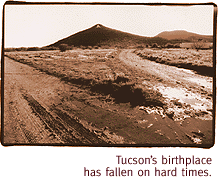 Last May, after years of collective neglect of the historic
site, the citizens were persuaded of the same thing. In a bond
election for open land and parks, the voters agreed to foot the
bill for buying some of the land necessary for San Agustín
park. Mayro said the county is using the approved $500,000 to
buy Mission Gardens, the five-acre plot at the intersection of
Mission Lane and Mission Road, where in the late 18th and early
19th centuries the priests and Pima villagers grew figs and apricots,
peaches and grapes in a walled garden.
Last May, after years of collective neglect of the historic
site, the citizens were persuaded of the same thing. In a bond
election for open land and parks, the voters agreed to foot the
bill for buying some of the land necessary for San Agustín
park. Mayro said the county is using the approved $500,000 to
buy Mission Gardens, the five-acre plot at the intersection of
Mission Lane and Mission Road, where in the late 18th and early
19th centuries the priests and Pima villagers grew figs and apricots,
peaches and grapes in a walled garden.
The voters did not, however, agree to pay enough to buy the
whole site, particularly the plot where the priests' Convento
and chapel and granary and other outbuildings stood. So the city
is working on a land trade with the proprietors of Citizens' Auto
Transfer, the tour-bus business that now stands on the hallowed
ground. The deal might not be struck for another year, though.
As John Updike, a staffer in the city manager's office, explains,
"We are exploring trade opportunities. There wasn't enough
money in the county-based project. We're in the early stages--I
hope in the next year we can identify a location."
The park's proponents are keeping a careful eye on proposals
for Rio Nuevo South. They worry about huge parking lots disrupting
the visual peace of the park.
"It must be done sensitively, it must be compatible,
it must not overwhelm the site," says Marty McCune, historic
program administrator for the city.
Meantime, Mayro says there's plenty of work to be done, including
archaeological and historical research, and the tricky search
for funding. Mayro believes that the cost of rebuilding the Convento
alone could reach $10 million. And she worries about "the
question of authenticity. We don't have a real good description
of the interior. It was already a ruin by the late 1880s."
City Council Member Steve Leal has argued long and passionately
for a reconstruction of the Convento. He says that the city of
Santa Barbara is reconstructing some of their early Spanish ruins
with far less information than Tucson has on the Convento. And
Leal has an idea, borrowed from Santa Barbara, that would at
once reduce costs and help to heal the wound made by the neglect
of the place.
"In Santa Barbara, they got different neighborhoods to
come out and make adobe bricks. If we think of this as Tucson's
birthplace, and if we think about the cultural geography of the
city, think about the various parts of Tucson coming back to make
bricks here, there's something profound about that, something
healing."
--Margaret Regan
|
 |





